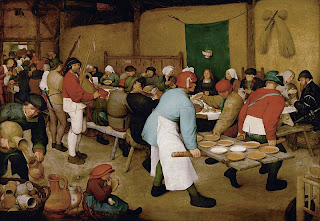Earlier in class, Tanner and I talked about how Burckhardt seemed to overlook the peasant class in his analysis of the renaissance. Renaissance painter Pieter Bruegel, on the other hand, saw the peasant class as more than just a collective mob of discontent. He saw them instead as unique individuals, each one living out a different aspect of the collective human experience.
Sometimes referred to as "Peasant Bruegel" or "Bruegel the Peasant", Bruegel would dress up and live as a peasant for extended periods of time in order to better get an understanding of the peasant lifestyle. It is obvious that his paintings were inspired by this first hand experience. The majority of Bruegel's paintings featured some aspect of normal peasant life like the wedding shown below. He also painted many religious works and even dabbled in political satire.His unique artistic style earned him the title of "Master" within the painters guild at Antwerp.
The Peasant Wedding


I like that you refered to The Peasant Wedding. For us it may seems "normal" that Brueghel painted a seen like a wedding, but for the 16th century it was not. The Genre Art - the Art of the ordinary people and their daily life - was not a common theme for artists these days. But Brueghel made it subject for many of his paintings, as you mentioned. And with that he kind of pushed the Genre Art to what it became in the 18th and 19th century.
ReplyDeleteThese kind of paintings of the peasant experience were far more common in Northern Europe than in Italy. That might explain a bit more of the differences between the North of Italy and the South. I am a huge Brueghel fan, and use a lot of his work in my classes. Most of the time it is very realistic, for instance kids playing hoop and a man with a wooden leg. But sometimes even he uses a bit of bias in his artwork, for instance painting peasants drunk and in more erotic/happy joy that demarcates the rising separation between social classes. Weird fact: I went to a Breughel exhibit in Rome this summer, payed $30 per family member ($120), and it turned out that it was the family Brueghel through the 18th century. The successive generations were not the geniuses of the father-son pair of the sixteenth century.
ReplyDelete